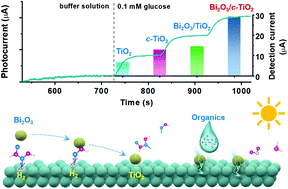A surface precleaning strategy intensifies the interface coupling of the Bi2O3/TiO2 heterostructure for enhanced photoelectrochemical detection properties†
Abstract
The interfacial coupling effect plays a crucial role in tailoring the photoelectrochemical performance of heterostructured photocatalysts. However, it is an urgent need but challenging to intensify the interfacial coupling effect of heterojunctions. Herein, we proposed the surface precleaning of n-type TiO2via a facile low-temperature hydrogenation to facilitate strong coupling with p-type Bi2O3 (Bi2O3/c-TiO2) and thus disruptively accelerate the electron transfer and electron–hole pair separation. The comparative studies of uncleaned Bi2O3/TiO2 and Bi2O3/c-TiO2 heterostructures by X-ray photoelectron spectroscopy revealed an unneglected valence change and thus a highly strong coupling effect between Bi2O3 and the cleaned TiO2 originating from a possible weakening role of the nitrogen species adsorbed on the surface of pristine TiO2 for the interfacial coupling effect. When integrated into a photoelectrochemical sensor, Bi2O3/c-TiO2 presented both significantly high detection photocurrent response and selectivity for organics in a buffer solution. The current response of the as-built Bi2O3/c-TiO2 was two-fold higher than that of uncleaned Bi2O3/TiO2 and was even almost five-fold that of bulk TiO2. We believe that this work will provide new perspectives and insights into the construction of efficient heterojunctions for impressive applications in photoelectrochemical detection.



 Please wait while we load your content...
Please wait while we load your content...